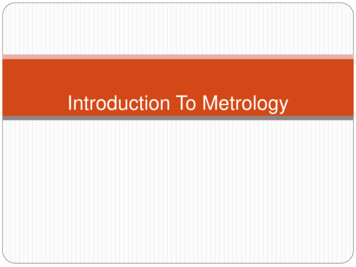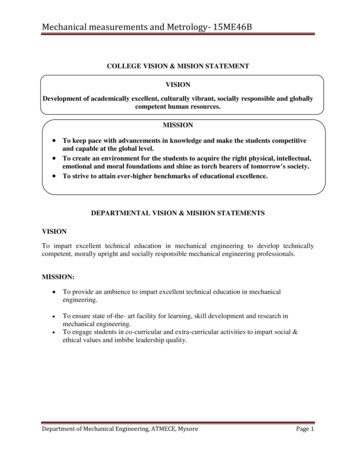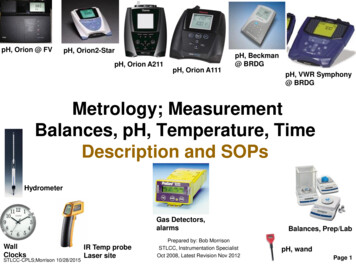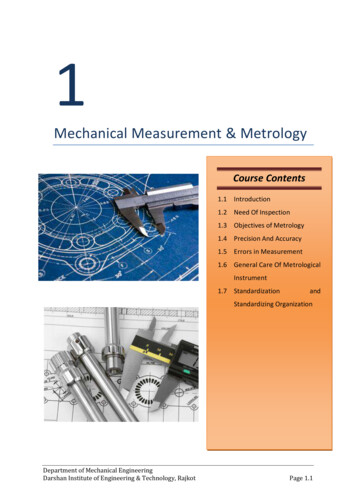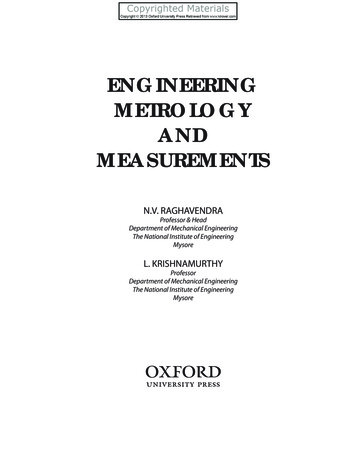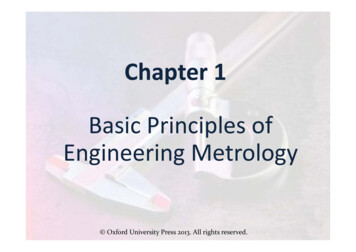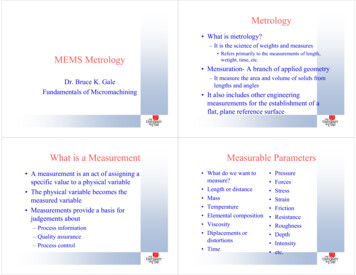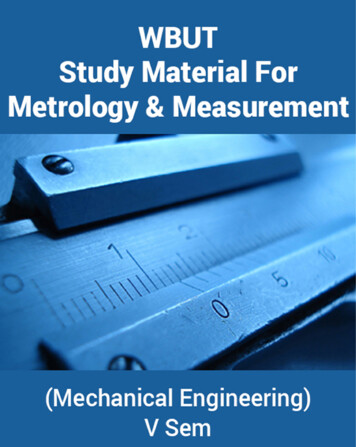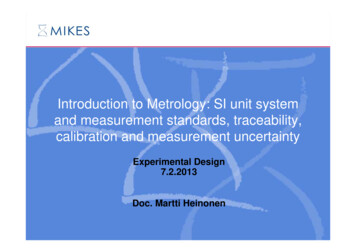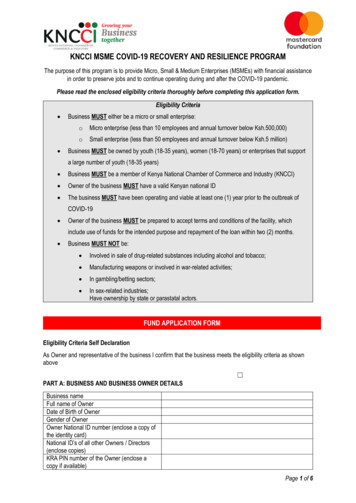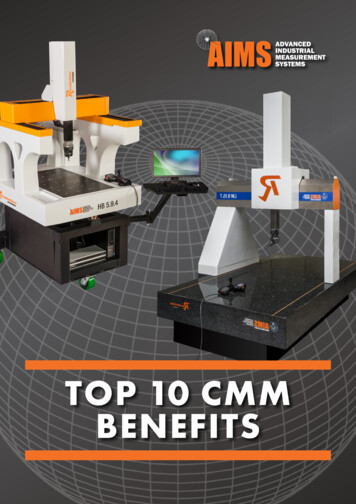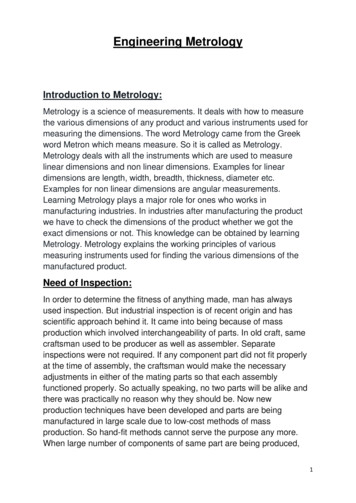
Transcription
Engineering MetrologyIntroduction to Metrology:Metrology is a science of measurements. It deals with how to measurethe various dimensions of any product and various instruments used formeasuring the dimensions. The word Metrology came from the Greekword Metron which means measure. So it is called as Metrology.Metrology deals with all the instruments which are used to measurelinear dimensions and non linear dimensions. Examples for lineardimensions are length, width, breadth, thickness, diameter etc.Examples for non linear dimensions are angular measurements.Learning Metrology plays a major role for ones who works inmanufacturing industries. In industries after manufacturing the productwe have to check the dimensions of the product whether we got theexact dimensions or not. This knowledge can be obtained by learningMetrology. Metrology explains the working principles of variousmeasuring instruments used for finding the various dimensions of themanufactured product.Need of Inspection:In order to determine the fitness of anything made, man has alwaysused inspection. But industrial inspection is of recent origin and hasscientific approach behind it. It came into being because of massproduction which involved interchangeability of parts. In old craft, samecraftsman used to be producer as well as assembler. Separateinspections were not required. If any component part did not fit properlyat the time of assembly, the craftsman would make the necessaryadjustments in either of the mating parts so that each assemblyfunctioned properly. So actually speaking, no two parts will be alike andthere was practically no reason why they should be. Now newproduction techniques have been developed and parts are beingmanufactured in large scale due to low-cost methods of massproduction. So hand-fit methods cannot serve the purpose any more.When large number of components of same part are being produced,1
then any part would be required to fit properly into any other matingcomponent part. This required specialization of men and machines forthe performance of certain operations. It has, therefore, been considerednecessary to divorce the worker from all round crafts work and tosupplant hand-fit methods with interchangeable manufacture.The modern production techniques require that production of completearticle be broken up into various component parts so that the productionof each component part becomes an independent process. The variousparts to be assembled together in assembly shop come from variousshops. Rather some parts are manufactured in other factories also andthen assembled at one place. So it is very essential that parts must beso fabricated that the satisfactory mating of any pair chosen at random ispossible. In order that this may be possible, the dimensions of thecomponent part must be confined within the prescribed limits which aresuch as to permit the assembly with a predetermined fit. Thus industrialinspection assumed its importance due to necessity of suitable mating ofvarious components manufactured separately. It may be appreciatedthat when large quantities of work-pieces are manufactured on the basisof interchangeability, it is not necessary to actually measure theimportant features and much time could be saved by using gaugeswhich determine whether or not a particular feature is within theprescribed limits. The methods of gauging, therefore, determine thedimensional accuracy of a feature, without reference to its actual size.The purpose of dimensional control is however not to strive for the exactsize as it is impossible to produce all the parts of exactly same size dueto so many inherent and random sources of errors in machines and men.The principal aim is to control and restrict the variations within theprescribed limits. Since we are interested in producing the parts suchthat assembly meets the prescribed work standard, we must not aim ataccuracy beyond the set limits which, otherwise is likely to lead towastage of time and uneconomical results.Lastly, inspection led to development of precision inspection instrumentswhich caused the transition from crude machines to better designed andprecision machines. It had also led to improvements in metallurgy andraw material manufacturing due to demands of high accuracy andprecision. Inspection has also introduced a spirit of competition and ledto production of quality products in volume by eliminating tooling bottlenecks and better processing techniques.2
Application of inspection1. To ensure that the part material or a component conforms to theestablished standard. For dimensional control as per specification.2. To meet the interchangeability of manufacture.3. To control the performance of man and manufacturing process.4. It helps in the process of quality control.5. It protects the customers in accepting family products.6. It helps in mass production of assembled part.7. It helps to assemble various parts produce at different station/place.8. It provides the means of finding out shortcoming in manufacture.Systems of measurementThere are two main systems for measuring distances and weight, theImperial System of Measurement and the Metric System ofmeasurement. Most countries use the Metric System, which uses themeasuring units such as meters and grams and adds prefixes like kilo,milli and centi to count orders of magnitude. In the United States, we usethe older Imperial system, where things are measured in feet, inches andpounds. It might be confusing if you are living in the U.S for the first timeand are not used to this system. If you ask someone for directions, theywill probably tell you something is a certain number of miles away. Oryou may be told to move a few feet But, whose feet?The Imperial System is also called The British Imperial because it camefrom the British Empire that ruled many parts of the world from the 16thto the 19th century. After the U.S gained independence from Britain, thenew American government decided to keep this type of measurement,even though the metric system was gaining in popularity at the time.We are one of the few countries in the world that still use this system,and first time visitors may find it confusing. Here are a few things toremember that will come in handy day to day:1 mile equals 1.6 Kilometers.1 inch is about 25 millimeters or 2.54 centimetersA 3-foot measurement is almost exactly 1 meter1 Kilogram is just over 2 pounds1 pound is about 454 gramsFor British visitors, 100 pounds 7.14 stone3
Complicated measurements, used in the sciences for example, will be inthe metric system so no need to worry if you are planning to do aninternship in engineering or chemistry.By the way, the temperature scales are different too. We didn't want tomake things too easy for you! Though not technically part of the metricsystem, Americans measure temperature in Fahrenheit, not Centigrade.You may turn on the television and listen for the weather and hear that itis 70 degrees outside. No, you won't pass out and be vaporized by thesun; 70 degrees Fahrenheit is actually very pleasant, about 21 degreesCentigrade. Centigrade has been used around the world from the mid20th century but again, Americans held fast to the original Fahrenheitsystem.Here are some more handy conversions for temperature:0 degrees Celsius is equal to 32 degrees Fahrenheit. (The freezingpoint), 24 degrees Celsius is equal to 75 degrees Fahrenheit. (A verypleasant day). To convert Celcius (c) to Fahrenheit, use the formula (c *1.8) 32. There is no reason to expect that we will change over to theMetric System and Centigrade anytime soon. The chances that we willmake the switch during your short-term stay in the United States areslim, so your best bet is to try to adjust as much as possible. Or, if youhave a smart phone, you can do what I do when I travel-- download aconversion app. The company World Wide Metric has a comprehensiveand easy to use conversion webpage.Advantages of the metric system1. Calculations are easier. If you want half or a fourth, it is easier todivide.2. It’s based on a system of 10s. We have 10 toes and 10 fingers,so counting is easier. Learning math as kids becomes easierbecause its always in 10s.3. Conversion is easiera. 1m 100cm 1000mm vs. 1 mile 1760 yards and 5280 feetb. 1kg 1000g vs. 1 stone is 14 pounds and 224 ounces4. You can measure a wide range from tiniest measurement to thelargest are common and don’t need to remember much (point 5)a. kg, g, mg, vs. lb, oz,5. Remembering the prefix is easy.4
a. deca 10, centi 100 (like century), mili 1000 etc (ok, there areexceptions in the metric also). kg, g, mg, ug6. It’s not only the 10s of one unit, but the metric system is suchthat everything takes water as the basisa. water freezes at 0C (32F) and boils at 100C (212F). Which iseasier to remember? (now add 273 to convert to metric).b. 1 litre of water has a mass of 1kg. 1 gallon of water is 8.34lb (Ithink). Which is easier to remember?7. It’s easier to have tools you can use anywhere (especially formanufacturing) and scientific applicationsDefinition of AccuracyBy the term ‘accuracy’, we mean the degree of compliance with thestandard measurement, i.e. to which extent the actual measurement isclose to the standard one, i.e. bulls-eye. It measures the correctnessand closeness of the result at the same time by comparing it to theabsolute value.Therefore, the closer the measurement, the higher is the level ofaccuracy. It mainly depends on the way; data is collected. In math,science, and engineering, accuracy refers to how close a measurementis to the true value.The ISO (International Organization for Standardization) applies a morerigid definition, where accuracy refers to a measurement with both trueand consistent results. The ISO definition means an accuratemeasurement has no systematic error and no random error. Essentially,the ISO advises the term accurate be used when a measurement is bothaccurate and precise.Definition of PrecisionThe terms precision and accuracy are used in connection with theperformance of the instrument. Precision is the repeatability of themeasuring process. It refers to the group of measurements for the samecharacteristics taken under identical conditions. It indicates to whatextent the identically performed measurements agree with each other. Ifthe instrument is not precise it will give different (widely varying) resultsfor the same dimension when measured again and again. The set ofobservations will scatter about the mean. The scatter of thesemeasurements is designated as 0, the standard deviation. It is used as5
an index of precision. The less the scattering more precise is theinstrument. Thus, lower, the value of 0, the more precise is theinstrument.Examples of Accuracy and Precision:You can think of accuracy and precision in terms of a basketball player.If the player always makes a basket, even though he strikes differentportions of the rim, he has a high degree of accuracy. If he doesn't makemany baskets, but always strikes the same portion of the rim, he has ahigh degree of precision. A player who throws free throws that alwaysmake the basket the exact same way has a high degree of bothaccuracy and precision.Take experimental measurements for another example of precision andaccuracy. If you take the measurements of the mass of a 50.0-gramstandard sample and get values of 47.5, 47.6, 47.5, and 47.7 grams,your scale is precise, but not very accurate. If your scale gives youvalues of 49.8, 50.5, 51.0, 49.6, it is more accurate than the firstbalance, but not as precise. The more precise scale would be better touse in the lab, providing you made an adjustment for its error.Difference Between Accuracy and PrecisionAccuracy is how close a value is to its true value. An example would behow close an arrow gets to the bulls-eye center.Precision is how repeatable a measurement is. An example would behow close a second arrow is to the first one (regardless of whether eitheris near the mark).Percent error is used to assess whether sufficiently accurate & precise.You can think of accuracy and precision in terms of hitting a bulls-eye.Accurately hitting the target means you are close to the center of thetarget, even if all of the marks are on different sides of the center.Precisely hitting a target means all the hits are closely spaced, even ifthey are very far from the center of the target. Measurements which areboth precise and accurate are repeatable and very near true values.6
Accuracy and precision are two important factors to consider whentaking data measurements. Both accuracy and precision reflect howclose a measurement is to an actual value, but accuracy reflects howclose a measurement is to a known or accepted value, while precisionreflects how reproducible measurements are, even if they are far fromthe accepted value.Comparison ChartBASIS FORACCURACYCOMPARISONMeaningAccuracy refers to the level ofagreement between theactual measurement and theabsolute measurement.PRECISIONPrecision implies the levelof variation that lies in thevalues of severalmeasurements of thesame factor.RepresentsHow closely result agree withthe standard value?How closely the resultsagree with one another?DegreeDegree of conformityDegree of reproducibilityFactorSingle factorMultiple factorsMeasure ofStatistical biasStatistical variabilityConcernedwithSystematic ErrorRandom Error7
Accurate and PreciseAccurate, but not PrecisePrecise.but not AccurateNeither Accurate nor PreciseKey Differences Between Accuracy and PrecisionThe difference between accuracy and precision can be drawn clearly onthe following grounds:1. The level of agreement between the actual measurement and theabsolute measurement is called accuracy. The level of variationthat lies in the values of several measurements of the same factoris called as precision2. Accuracy represents the nearness of the measurement with theactual measurement. On the other hand, precision shows thenearness of an individual measurement with those of the others.3. Accuracy is the degree if conformity, i.e. the extent to whichmeasurement is correct when compared to the absolute value. Onthe other hand, precision is the degree of reproducibility, whichexplains the consistency of the measurements.8
4. Accuracy is based on a single factor, whereas precision is basedon more than one factor.5. Accuracy is a measure of statistical bias while precision is themeasure of statistical variability.6. Accuracy focuses on systematic errors, i.e. the errors caused bythe problem in the instrument. As against this, precision isconcerned with random error, which occurs periodically with norecognizable pattern.ConclusionSo, if the actual measurement is high in accuracy and precision, theresult would be free from errors. If the actual measurement is precise butinaccurate, then the result is in disagreement with the expected one. Ifthe actual result is accurate but imprecise, then there are hugevariations in the measurements. And finally, if the actual measurement isneither accurate nor precise, then the result would lack correctness andexactness at the same time.Calibration.Calibration is the process of determining and adjusting an instrumentaccuracy to make sure its accuracy is within the manufacture’sspecifications.The calibration of any measuring system is very important to getmeaningful results. In case where the sensing system and measuringsystem are different, then it is imperative to calibrate the system as anintegrated whole in order to take into account the error producingproperties of each component. Calibration is usually carried out bymaking adjustments such that readout device produces zero output forzero-measurement and input, and similarly it should display an outputequivalent to the known measure and input near the full-scale inputvalue. It is important that any measuring system calibration should beperformed under environ-mental conditions that are as close as possibleto those conditions under which actual measurements are to be made. Itis also important that the reference measured input should be known toa much greater degree of accuracy—usually the calibration standard forthe system should be at least one order of magnitude more accuratethan the desired measurement system accuracy, i.e. accuracy ratio of10: 1.9
Importance of CalibrationCalibration is a comparison between a known measurement (thestandard) and the measurement using your instrument. Calibration ofmeasuring instruments has two objectives. It checks the accuracy of theinstrument and it determines the traceability of the measurement. Inpractice, calibration also includes repair of the device if it is out ofcalibration. A report is provided by the calibration expert, which showsthe error in measurements with the measuring device before and afterthe calibration.To explain how calibration is performed we can use an externalmicrometer as an example. Here, accuracy of the scale is the mainparameter for calibration. In addition, these instruments are alsocalibrated for zero error in the fully closed position and flatness andparallelism of the measuring surfaces. For the calibration of the scale, acalibrated slip gauge is used. A calibrated optical flat is used toWhy calibration is important?The accuracy of all measuring devices degrade over time. This istypically caused by normal wear and tear. However, changes inaccuracy can also be caused by electric or mechanical shock or ahazardous manufacturing environment (oils, metal chips etc.).Depending on the type of the instrument and the environment in which itis being used, it may degrade very quickly or over a long period of time.The bottom line is that, calibration improves the accuracy of themeasuring device. Accurate measuring devices improve product quality.When should you calibrate your measuring device?A measuring device should be calibrated:According to recommendation of the manufacturer.After any mechanical or electrical shock.Periodically (annually, quarterly, monthly)Hidden costs and risks associated with the un-calibrated measuringdevice could be much higher than the cost of calibration. Therefore, it isrecommended that the measuring instruments are calibrated regularly bya reputable company to ensure that errors associated with themeasurements are in the acceptable range.10
Accuracy, Precision, and CalibrationDo you think it is better to use an instrument that records accuratemeasurements or one that records precise measurements? If you weighyourself on a scale three times and each time the number is different, yetclose to your true weight, the scale is accurate. Yet, it might be better touse a scale that is precise, even if it is not accurate. In this case, all ofthe measurements would be very close to each other and "off" from thetrue value by about the same amount. This is a common issue withscales, which often have a "tare" button to zero them.While scales and balances may allow you to tare or make an adjustmentto make measurements both accurate and precise, many instrumentsrequire calibration. A good example is a thermometer. Thermometersoften read more reliably within a certain range and give increasinglyinaccurate (but not necessarily imprecise) values outside of that range.To calibrate an instrument, record how far off its measurements are fromknown or true values. Keep a record of the calibration to ensure properreadings. Many pieces of equipment require periodic calibration toensure accurate and precise readings.Calibration vs. CertificationCalibration is the process of checking the dimensions.and tolerances of a gauge, or the accuracy of a measurementinstrument by comparing it to a like instrument/gauge that has beencertified as a standard of known accuracy. Calibration is done bydetecting and adjusting any discrepancies in the instrument’s accuracyto bring it within acceptable limits. Calibration is done over a period oftime, according to the usage of the instrument and thematerials of its parts. The dimensions and tolerances of the11
instrument/gauge are checked to determine whether it has departed fromthe previously accepted certified condition. If departure iswithin limits, corrections are made. If deterioration is to a point thatrequirements can’t be met any more then the instrument/gauge can bedowngraded and used as a rough check, or it may be reworked andrecertified, or be scrapped. If a gauge is used frequently, it will requiremore maintenance and more frequent calibration.Certification is performed prior to use of instrument/gauge and later toreverify if it has been reworked so that it again meets its requirements.Certification is given by a comparison to a reference standard whosecalibration is traceable to an accepted national standard. Further suchreference standards must have been certified and calibrated as masternot more than six months prior to use.Factors affecting of the measuring system:The basic objective of metrology should be to provide the accuracyrequired at the most economical cost. The accuracy of measuringsystem includes elements such as :(a) Calibration Standards,(b) Workpiece being measured,(c) Measuring Instruments(d) Person or Inspector carrying out the measurement, and(c) Environmental influences.The above arrangement and analysis of the five basic Metrologyelements can be composed into the acronym SWIPE for convenientreference : S Standard, W Workpiece, I Instrument, P Personand E Environment.Higher accuracy can be achieved only if, all the sources of errors due tothe above five elements in the measuring system be analyzed and stepstaken to eliminate them. An attempt is made here to summarize theVarious factors affecting these five elements.1. Standard.lt may be affected by ambient influences (thermalexpansion), stability with time, elastic properties, geometric compatibility,and position of use.2. Workpiece, itself may be affected by ambient influences, cleanliness,surface condition, elastic properties, geometric truth, arrangement ofsupporting it, provision of defining datum etc.12
3. Instrument may be affected by hysteresis, backlash, friction, zero drifterror, deformation in handling or use of heavy work pieces, inadequateamplification, errors in amplification device, calibration errors, standarderrors, correctness of geometrical relationship of workpiece andstandard, proper functioning of contact pressure control, mechanicalparts (slides, ways, or moving elements) working efficiently, andrepeatability adequacy etc.4. Personal errors can be many and mainly due to improper training inuse and handling skill, sense of precision and accuracy appreciation,proper selection of instrument, attitude towards and realization ofpersonal accuracy achievements, etc.5. Environment exerts a great influence. It may be affected bytemperature ; thermal expansion effects due to heat radiation from light,heating of components by sunlight and people, temperature equalizationof work, instrument and standard ; surroundings; vibrations ; lighting;pressure gradients (affect optical measuring systems) etc.Sources of errors1. Calibration errorEach measures instrument should be calibrated with a standard one atcertain time interval (may be once in a year once in every 6 months)If the above procedure is not followed the instrument may giveerroneous result, it is called calibration errors.2. Environmental errorThese errors are due to surrounding in pressure temperature andhumidity. Internationally agree standard value of temperature pressureare : (i) Temperature 20 c (ii) Pressure 760 mm of Hg 10 mm of Hgvapor pressure. If the ambient condition various from the above standardvalves the measured value will be erroneous.3. Contact pressure/ stylus pressureErrors are also introduced due to pressure exerted at stylus. It ismore prominent in case of soft work piece. Ideally the stylus shouldtouch the top surface of w/p. due to stylus pressure both deformation &deflection of w/p take place. This type of errors are also induced whenthe force applied on the anvils of micrometer varies.13
4. Error due to supportsThe elastic deformation/ deflection of a long measuring bar due toposition of support cause error in measurement. So G.B Airy found outthe position of supports to give minimum error. Two support conditionsare: (i) for minimum deflection (fig 1.3) (ii) for zero slope at ends (fig 1.4)5. Error due to alignmentAbbe’s alignment principle should be followed to avoiderror due to alignment. According to this principle the axisof measurement should coincide with measuringinstruments.If D True dia L Apparent length α micrometer arivil diaThen D L cos θ - α sin θ, Error L-D L- (L cos θ - α sin θ)14
sin & cosine error both6. Parallax erroroccur when line of vision is not directly in line with measuringscale PA parallax error7.Error due to dustPresence of dust in the atmosphere change reading in the order offraction of micron. When high accuracy in measurement is required dustshould be cleaned by clean chamois.8.Error due to vibrationThe instrument anvil will not give consistent and repetitive reading if it issubjected to vibration. So the measurement should be taken away fromthe source of vibration.9. Error due to locationIf the datum surface is not perfectly flat or if any foreign matter such asdirt chip etc. are present between the datum and w/p error occurs inmeasurement as shown in fig 1.8.15
10. Error due to poor contacti. The measured dimension will be greater than the actual dimension dueto poor contact as shown in fig 1.9.ii. Error due to wear in gaugesThe anvil of micrometer is subjected to wear due to repeated use andlead to error in measurement. The lack of parallelism due to wear ofanvil can be checked by optical flat.Basically errors are of 2 typesi) Controllable ( or systematic) error,(ii) Uncontrollable (or Random) errorDefinition of Systematic ErrorThe constant error occurs in the experiment because of the imperfectionof the mechanical structure of the apparatus is known as the systematicerror. The systematic errors arise because of the incorrect calibration ofthe device. The error is mainly categorized into three types.1. Instrumental Error, 2. Environmental Error, 3. Observational ErrorInstrumental Error – The instrumental error occurs because of thethree reasons. 1. Misuse of the apparatus. 2. Imperfection in themechanical structure of the apparatus. 3. The error occurs because ofthe loading effect.16
Observational Error – The error occurs in the observation of thereading is known as the observational error. For example, consider thepointer of voltmeter rest on the surface of the scale. The observationalerror occurs in the reading if the line of vision is exactly not above thepointer.Environmental Error – Such types of error occurs because of thechanges in the surroundings condition like humidity, pressure, magneticor electrostatic field, etc. The experimental errors can be reduced bymaking some arrangements in the laboratory for controlling thetemperature and humidity. Also, before experimenting make ensure thatthere should be no magnetic and electric field.Definition of Random ErrorThe uncertain disturbances occur in the experiment is known as therandom errors. Such type of errors remains in the experiment even afterthe removal of the systematic error. The magnitude of error varies fromone reading to another. The random errors are inconsistent and occur inboth the directions.The presence of random errors is determined only when the differentreadings are obtained for the measurement of the same quantity underthe same condition.17
Key Differences between the Random & Systematic ErrorThe following are the major differences between the systematic andrandom error.1. The random error means the unpredictable disturbance occurs in theexperiment by the unknown source. Whereas, the systematic erroroccurs because of the inbuilt defect of the apparatus.2. The random error occurs in both the direction, whereas the systematicerror occurs only in one direction. The systematic errors arise becauseof the inbuilt fault of the apparatus, hence it always gives the same error.The random error occurs because of the unknown source, therebyoccurs in any direction.3. The magnitude of systematic error remains constant because thedefect is inbuilt inside the apparatus. Whereas, the magnitude of therandom error is variable.4. The zero error and the incorrect calibration of apparatus cause thesystematic error. The random error is because of the parallax or byincorrectly using the apparatus.5. The random error reduces by taking the two or more readings of thesame experiment, whereas the systematic error reduces by carefullydesigning the apparatus.6. The random error does not have any specific types, whereas thesystematic error is categorized into three types, i.e., instrument error,environment error and systematic error.7. The random error is non-reproducible whereas the systematic error isreproducible because the defect is inbuilt with the apparatus.ConclusionThe random error happens because of any disturbances occurs in thesurrounding like the variation in temperature, pressure or because of theobserver who takes the wrong reading. The systematic error arisesbecause of the mechanical structure of the apparatus. The completeelimination of both the error is impossible.Random errori. This error is due to error in theposition of standard & workpressure due to displacement oflever joint due to friction & play inSystematic errori. This error includes calibrationerror contact pressure errorvariation in atmospheric conditionsparallax misalignment zero error18
instrument linkage due to improperestimation in Judgingfractional part of a scale divisionetc.ii. These errors are interest inmeasuring systemiii. These errors are no consistent &non repetitiveiv. These errors can’t be eliminatedetc.ii. These e
Engineering Metrology Introduction to Metrology: Metrology is a science of measurements. It deals with how to measure the various dimensions of any product and various instruments used for measuring the dimensions. The word Metrology came from the Greek word Metron which mean
